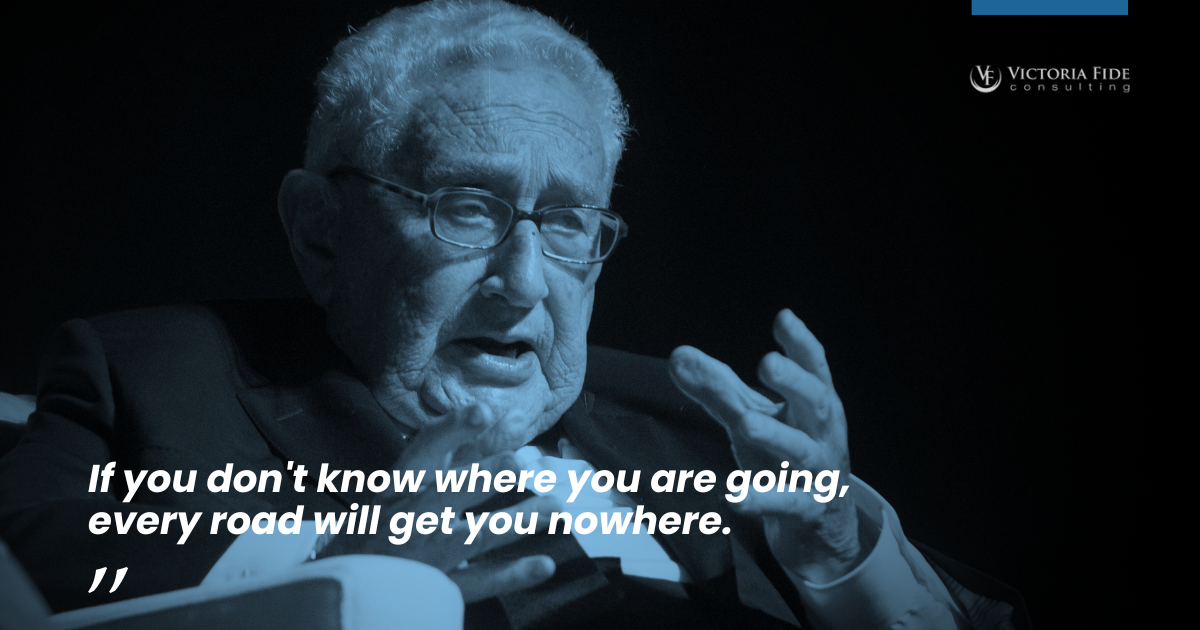
Managing Requirements with Kissinger’s Guiding Principle
The Sage Wisdom series is produced by Victoria Fide Marketing with input and oversight from our leadership team and industry SMEs.
Henry Kissinger, (1923-2023), was a distinguished American political figure and Nobel Peace Prize laureate. Kissinger’s life is one of inspiring perseverance and overcoming obstacles. In 1938 he came to America as a Jewish refugee fleeing from Nazi persecution, and eventually became an influential leader and trusted political advisor. His profound insights into international relations and diplomacy served him well during his tenure as the United States Secretary of State under Presidents Richard Nixon and Gerald Ford. On Wednesday, November 29th, Kissinger passed away just six months after his 100th birthday.
Kissinger’s quote, “If you don’t know where you are going, every road will get you nowhere,” holds true for many areas, including in the context of digital transformation (DX). When it comes to technology integration, the importance of clearly documented requirements cannot be overstated. If the requirements are unknown or undocumented, every project will fail to meet them. In the absence of well-documented requirements, businesses risk wandering aimlessly in their digital endeavors, and will face challenges in meeting project goals and achieving meaningful business outcomes. Kissinger’s concise quote demonstrates a guiding principle that emphasizes the need for clarity and purpose in the pursuit of successful DX initiatives.
Know Where You Are Going: Clearly Defining Requirements
Some project leaders have – at the very least – a general understanding of what they want the technology to do; i.e. improve inventory management, streamline workflows or increase the amount of value-add activities. However, when asked to produce documentation, many frequently struggle to even articulate the necessary requirements much less provide documentation for them. This is often because the requirements have not been clearly defined.
If the requirements are not clearly defined, it will be impossible to provide accurate documentation. With no documentation, the implementation team will be unable to configure the technology to meet the requirements. This means that by the end of the project, organizations will have spent countless hours and dollars to adopt a new system that at best may leave gaps in the workflow, and at worst makes its processes that much more complicated.

Free PDF Download
In the rapidly changing digital landscape, more and more companies are desperately trying to keep up with the competition. Download “The 10 Biggest Mistakes Businesses Make in Digital Transformation” for free today to learn how to use DX to radically transform your business and gain an edge over your competitors.
This harkens back to Kissinger’s quote: “If you don’t know where you are going, every road will get you nowhere.” If the project requirements are nebulous, undefined, and undocumented, even the most cutting-edge technologies will not be able to meet them, and the business will not fully experience the success it could. As you can see, while requirements documentation isn’t very sexy, it plays a crucial role in determining both project success and the success of the organization as a whole.
Challenges of Undefined Requirements in Digital Endeavors
Let’s take an example of an organization looking to implement an Enterprise Resource Planning (ERP) system in the hopes of improving efficiency and preparing for new growth. What they did not realize was that without a clear understanding of the intricacies of the organization’s processes, goals, and user needs, it would be impossible to manage requirements and the ERP implementation may fall short of delivering the intended transformative impact. This oversight can result in a misalignment between the ERP solution and the unique demands of the business, potentially jeopardizing the anticipated improvements in workflow and productivity.
Unrecorded requirements lead to extensive internal and external communication challenges, necessitating repeat discussions of previously made decisions, and unnecessary back and forth with the implementation team. This iterative cycle often involves the incorporation of additional requirements, resulting in misalignment among stakeholders, the project team, and organizational leaders. This phenomenon, known as project thrashing, commonly brings projects to a standstill and can ultimately prove fatal for the project. In the rare event that the ERP system is successfully implemented, users inevitably encounter limitations in functionality, misalignment with organizational processes, and the imperative need for yet another digital transformation initiative to attain the initial goals.
This scenario is all too common with companies looking to undertake a digital transformation initiative. According to a Bain & Company survey in 2017, only 5% of digital transformations surveyed achieved or exceeded expectations. 20% failed to deliver desired results and 75% settled for “mediocre performance.” It is possible to have a technically successful integration without experiencing true project success. Usually when companies choose to undertake a DX project, it’s justified by specific business objectives. If those objectives are not being met – no matter how seamlessly a new system was adopted – then the project was not a success.

Transformation is not easy, but it doesn’t have to be impossible. Take control of your project’s success today and schedule a free 30-minute consultation to find out how Victoria Fide can equip you for transformational success.
Well-defined and clearly documented requirements are critical for on-time and on-budget implementations, functional solutions, and organizational success. By documenting requirements, it provides the internal team with the necessary alignment, enables clear communication with implementation partners, and paves the way for an effective technology roadmap.
Strategies for Clearly Documented Requirements
The first step in achieving well-defined and clearly documented requirements is a thorough analysis. This analysis should be comprehensive, covering every aspect of the business and its processes. It’s vital to gain a holistic view of how the organization functions and a clear picture of the current state of the company. By doing so, you can identify gaps in the system that the digital transformation aims to fill and prepare a roadmap for the journey ahead. Remember, you cannot improve what you don’t measure or understand.
The second step is to involve key stakeholders early and often. One of the main challenges in complex projects is miscommunication or misunderstanding of project requirements among stakeholders. To ensure everyone is on the same page, clear communication is essential. Keeping all relevant parties informed and aligned will help eliminate a lot of back and forth and miscommunication regarding requirements and what each stakeholder needs from the project. This not only streamlines the project execution but also helps in managing expectations and ensuring stakeholder satisfaction.
The third step is to adopt documentation best practices. If you do not have internal personnel on the implementation team that are experts in requirements gathering and documentation, make sure that your implementation team brings in the right business process consultants that are well-versed in best-practices for requirements gathering and documentation. It’s important that these experts truly understand the business in addition to knowing how to implement the technology. Effective requirements gathering may involve thorough questionnaires, interviews, analysis of past projects, and brainstorming sessions with key stakeholders.
Using clear and concise language to document the requirements is critical in minimizing the amount of miscommunication. Ensuring that each requirement is testable is essential in testing whether the proposed solution can meet the requirements. Additionally, organizing and prioritizing requirements based on their importance can help determine which requirements are needs, which are wants, and which can be implemented at a later date or phase. Remember, the goal of documenting requirements is to provide clear, concise, and comprehensive information that guides the project from inception to completion.

Guiding Your Organization in the Pursuit of Successful DX Initiatives
In conclusion, it’s worth revisiting the wisdom of Kissinger: “If you don’t know where you are going, every road will get you nowhere.” Vision and well-defined goals are the backbone of organizational growth and success. Without clear, measurable objectives, reaching your desired destination becomes a game of chance rather than a strategic journey.
A well-crafted roadmap for technology integration can help guide an organization towards its goals, while also identifying requirements and streamlining the requirements management process. This roadmap serves as a compass, ensuring each step taken aligns with the overarching business objectives.
However, creating this roadmap and defining these requirements aren’t easy tasks – it requires a deep understanding of both your organization’s needs and the digital landscape. This is where Victoria Fide’s expertise comes into play. We specialize in bridging the gap between your organizational strategy and the right implementation partner. At Victoria Fide, we do more than just consult – we roll up our sleeves and work alongside you. We help our clients define their requirements, build thorough documentation, and advocate on their behalf to ensure their organizational goals are met.
Whether you’re just starting your digital transformation journey or looking to optimize your existing initiatives, remember Kissinger’s words. Know where you’re going and let us help you get there. Get in touch with Victoria Fide today and make your digital transformation journey a resounding success.
Subscribe to our weekly LinkedIn Digital Transformation Success newsletter and get notified of each new edition.
